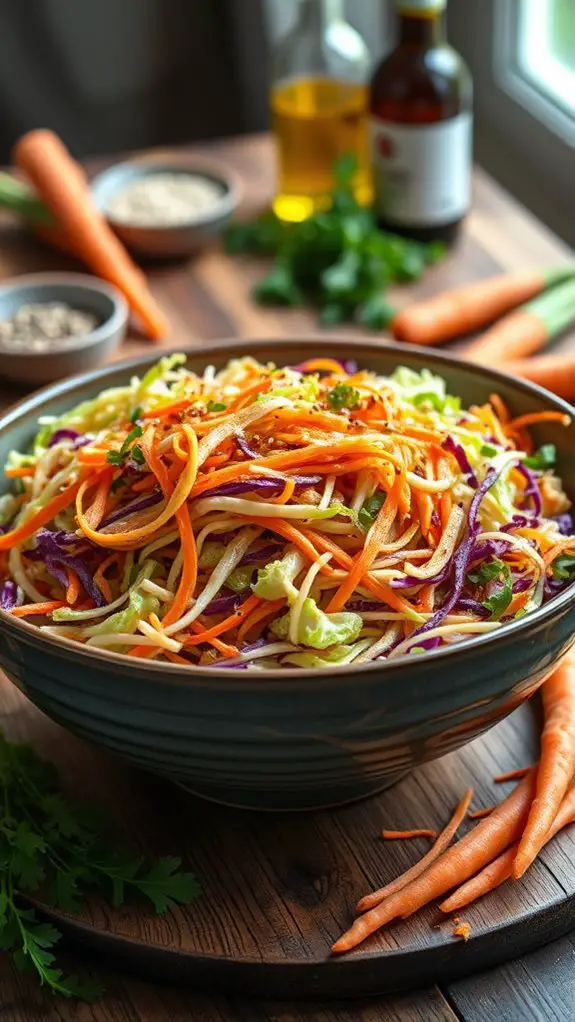Did you know that the global coleslaw market is projected to reach over $1.5 billion by 2025? This vibrant Asian twist on the classic dish combines crunchy ramen noodles and a tangy dressing, creating a unique flavor profile that has captured the attention of health-conscious consumers. Explore how this innovative recipe blends culinary traditions and offers a nutritious alternative to traditional coleslaw.
History

Although the origins of Asian coleslaw with ramen noodles can be traced back to various traditional Asian salad recipes, the specific dish as it's understood today emerged in the United States during the mid-20th century.
Drawing on cultural influences from Japan, China, and Southeast Asia, the dish evolved to incorporate ingredients like shredded cabbage, carrots, and the iconic crispy ramen noodles, which originated as an affordable and convenient food.
The combination of crunchy textures and tangy, sweet, and savory flavors has made Asian coleslaw with ramen noodles a beloved staple in American cuisine, reflecting the diverse culinary traditions that have shaped modern food culture.
Recipe

Crunchy, flavorful, and packed with nutrients, this Asian Coleslaw with Ramen Noodles is a delightful side dish that's sure to impress. The combination of shredded cabbage, carrots, and crunchy ramen noodles, tossed in a tangy Asian-inspired dressing, creates a revitalizing and satisfying salad that pairs perfectly with grilled meats, fish, or as a standalone meal.
The use of ramen noodles in this dish adds a unique and unexpected twist, providing a satisfying crunch that complements the tender vegetables. The dressing, made with a blend of rice vinegar, soy sauce, sesame oil, and honey, ties all the flavors together, resulting in a harmonious and well-balanced dish.
Ingredients:
- 1 (14 oz) package coleslaw mix
- 2 carrots, shredded
- 1 package ramen noodles, crushed (discard seasoning packet)
- 3 tablespoons rice vinegar
- 2 tablespoons soy sauce
- 1 tablespoon sesame oil
- 1 tablespoon honey
- 1 teaspoon freshly grated ginger
- 1/4 teaspoon crushed red pepper flakes (optional)
- Salt and pepper to taste
Instructions:
In a large bowl, combine the coleslaw mix, shredded carrots, and crushed ramen noodles.
In a small bowl, whisk together the rice vinegar, soy sauce, sesame oil, honey, ginger, and red pepper flakes (if using).
Pour the dressing over the vegetable and noodle mixture, and toss to coat evenly.
Season with salt and pepper to taste. Allow the salad to sit for 10-15 minutes before serving to allow the flavors to meld.
Tip: For added crunch and texture, toast the crushed ramen noodles in a dry skillet over medium heat for 2-3 minutes before adding them to the salad. This will give the noodles a delightful toasted flavor.
Nutritional Guide
This Asian Coleslaw with Ramen Noodles offers a nutritional punch.
It's rich in dietary fiber, providing over 25% of the recommended daily intake per serving. The cabbage and carrots are excellent sources of vitamins A and C, promoting healthy vision and immunity.
The ramen noodles, while higher in sodium, contribute B-vitamins and minerals like iron. This dish balances its indulgent textures with nutrient-dense ingredients, making it a well-rounded option.
Whether you're looking to boost your fiber intake or get more vitamins, this Asian-inspired slaw delivers on both fronts.
Its vibrant colors and crunchy textures also make it an appetizing and satisfying side or main dish.
Final Thought
While this Asian Coleslaw with Ramen Noodles offers a nutritional punch, it's worth considering the dish's potential drawbacks.
The flavor combinations can be polarizing, with the bold Asian seasonings contrasting sharply with the crunch of the noodles. Additionally, the high sodium content from the ramen packets may be a concern for some.
When preparing this dish, consider using low-sodium options or reducing the amount of seasoning packets. Experimenting with alternative cooking tips, such as roasting the noodles for a toastier texture, could enhance the overall flavor profile.
Ultimately, this dish requires balancing the nutritional benefits with personal preferences and dietary needs.